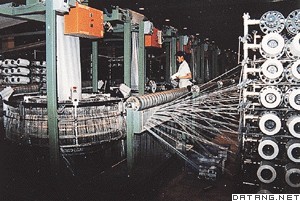1) parts of textile machine


纺织机械零件
1.
The application and investigate of CAPP for the parts of textile machine;


纺织机械零件CAPP技术的应用研究
2) ACCESSORIES FOR TEXTILE MACHINERY


纺织机械附件
3) textile machinery


纺织机械
1.
The Status-quo and Competitive Tactics Analyses on the National Textile Machinery Industry;
我国纺织机械产业的现状与竞争策略分析
2.
One Inverter Drives More Motors in Textile Machinery Field;


纺织机械中一台变频器拖动多台电机的应用
4) textile machine


纺织机械
1.
Early fault detection at textile machines with the help of structure-borne sound analysis


借助结构噪声分析检测纺织机械故障
2.
A data-bsed system of FJCAPP is designed for the small batch and mass typed in the manufacturing of textile machine.
针对纺织机械小批量、多品种的生产现状,设计了基于数据库的CAPP系统。
3.
The newest international textile machine and nonwoven equipment are on display at the exhibition, as also the process technology and development trend.
介绍了1999年第十三届国际纺织机械展览会概况。
5) Mechanical parts


机械零件
1.
Optimum design of the reliability of mechanical parts;


机械零件的可靠性优化设计
2.
Research on the Key Techniques for Reverse Modeling of Mechanical Parts;


机械零件反求建模关键技术研究
3.
Design of Measure and Control Platform for Reverse Modeling of Mechanical Parts;


机械零件反求建模测控平台设计
6) machinery parts


机械零件
1.
Application of the theory of low char martensite in the product of coal mine machinery parts;
低碳马氏体理论在煤矿机械零件生产中的应用
2.
The paper introduces that under special technology condition, Nona material infiltrates through matrixes of machinery parts to refine crystal grains, increase matrix tenacity, strength and hardness, reduce friction factors and high performance and long lifetime machinery parts are manufactured.
本文介绍在特定的工艺条件下,将纳米材料渗入到机械零件的基体中,使基体材料晶粒细化,韧性增加,强度增加,硬度增加,磨擦因数降低,从而制造出了高性能长寿命的机械零件。
3.
The test of machinery parts has very strong technicality.


机械零件检验是检验工作中技术性很强的问题,详细阐述了合理的检验工艺规程,介绍了几种有效的测量方法。
补充资料:纺织机械
| 纺织机械 textile machinery 把天然纤维或化学纤维加工成为纺织品所需要的各种机械设备。广义的纺织机械还包括生产化学纤维的化工机械。纺织机械是纺织工业的生产手段和物质基础,其技术水平、质量和制造成本,直接关系到纺织工业的发展。 人类最初用天然纤维作原料纺纱织布,早于文字的发明。中国在春秋战国时已经使用手摇纺车纺纱,宋代已经发明了30多个锭子的水力大纺车。1769 年,英国的K.阿克顿特制出水力纺纱机。1779年,英国的S.克朗普顿发明走锭纺纱机。1828年,美国的J.索普发明环锭纺纱机,因采用连续纺纱使生产率提高数倍。中国战国时期的织机已经运用了杠杆原理,以脚踏连杆带动综框完成开口动作。1733年,英国的J.凯发明飞梭,打击梭子使其高速飞行,织机生产率得以成倍提高。1785年,英国的E.卡特赖特发明动力织机,同年英国建成世界上第一个用蒸汽机为动力的棉纺织厂,这是纺织工业由工场手工业向大工业生产过渡的一个转折点。19世纪末~20世纪中期,人造纤维和合成纤维相继面世,从而拓宽了纺织机械的领域,增添了化学纤维机械一个门类。为适应化学纤维加工的需要,对纺、织、染整设备作了改进。20世纪50年代以后,一些新的纺纱织布方法相继出现,部分地取代了传统方法,以高得多的效率生产纺织物,如转杯纺纱、非织造布(俗称无纺布)等。新的工艺方法孕育着新的纺织设备,新的纺织设备成熟与推广,又促使纺织工业进一步向前发展。现代纺织机械的特点和发展方向为:①工艺性、连续性和成套性。②高速度、高效率和省维护。③标准化、系列化和通用化。④低能耗、低噪声和低公害。
纺织机械按生产过程分为纺纱设备、织造设备、印染设备、整理设备,另外还有化学纤维抽丝设备、缫丝设备和非织造布设备等。 |
说明:补充资料仅用于学习参考,请勿用于其它任何用途。
参考词条
